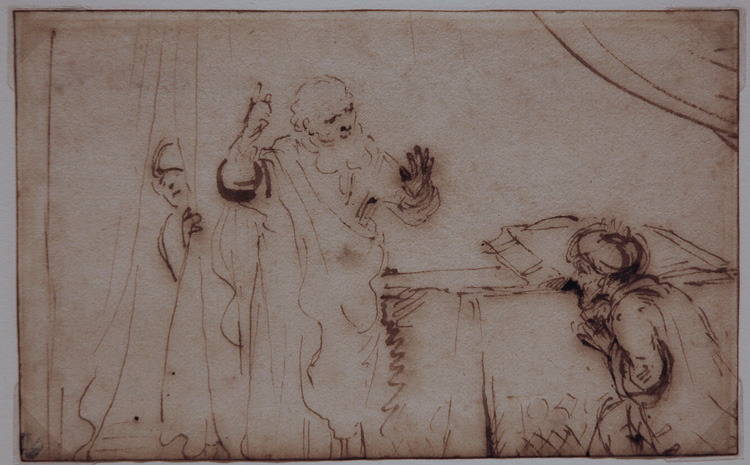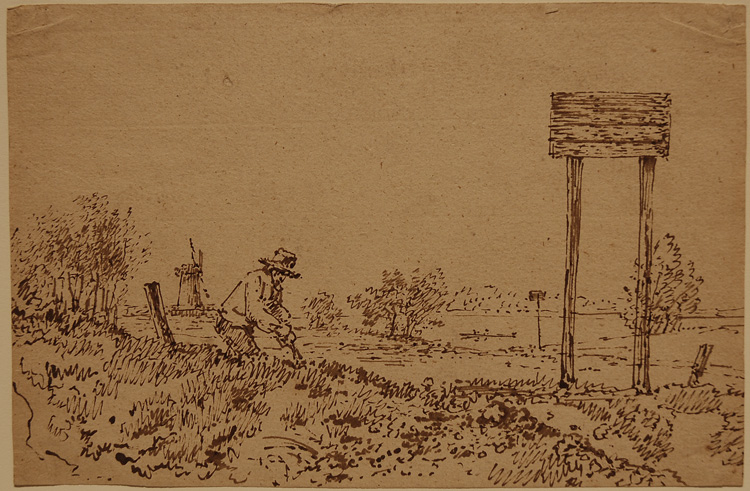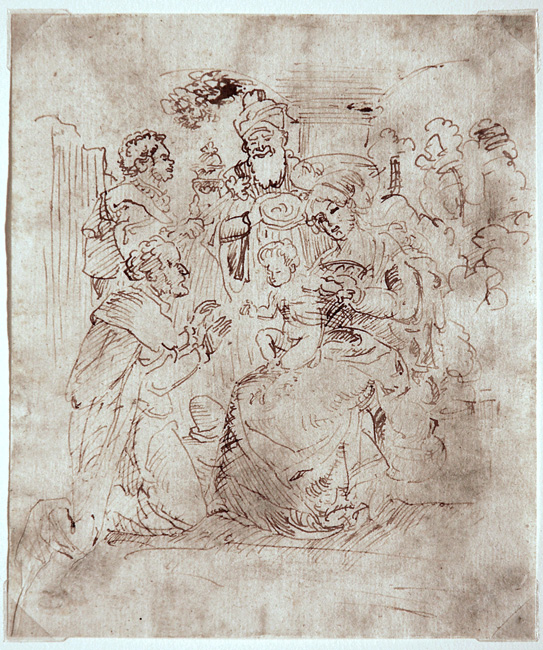Click image for BBB rating
See our Privacy Policy
cool="cool" width="802" height="3854" border="0" cellpadding="0" cellspacing="0" gridx="16" showgridx="showgridx" usegridx="usegridx" gridy="16" showgridy="showgridy" usegridy="usegridy" bgcolor="#99ccff">
|
 |
|
|
|
|
|
|
Welcome to Spaightwood Galleries, Inc.
120 Main Street, Upton MA 01568-6193; 800-809-3343; email: spaightwood@gmail.com
|
|
|
|
For Rembrandt and his friends, students, and followers, there often seems to be a direct connection between drawing and printmaking. Artists like Ferdinand Bol, Govaert Flinck, Jan Lievens, Nicolaes Maes, Jan Joris van Vliet, and Pieter de With, are fluent draftsmen and often excellent printmakers as well. While the Counter Reformation held sway in the south, in the north, in Holland and Zeeland, Jesus, the Apostles, and their predecessors in the Old Testament, walk the same ground that burghers, beggars, farmers, and peasants tred, work the same fields, trying to coexist with nature and yet to wrest it to their needs. Biblical stories, landscapes, and portraits can be a way to connect the present to the past and the future.
Very select bibliography: Marian Bosanz-Prakken, Rembrandt and His Time: Masterworks from the Albertina (Milwaukee: Milwaukee Art Museum, 2005); Hans-Martin Rotermund, Rembrandt's Drawings and Etchings for the Bible, trans. Sherry M. Weber (Philadelphia: Pilgrim Press, 1969); Seymour Slive, Drawings of Rembrandt, 2 vols. (NY: Dover. 1965); Jeroen Giltaij, The Drawings by Rembrandt and his school in the Museum Boymans-van Beuningen (Rotterdam: Museum Boymans-van Beuningen, 1988); Walter Sumowski, Drawings of the Rembrandt School, 10 vols. (NY: Abaris Books, 1979-1992).
|
|
|
|
 |
|
|
|
Nicolaes Maes (Dordrecht 1634-1693 Amsterdam) , The Prophet Nathan rebukes David. Pen and brown ink and wash on laid paper, c. 1650-1660. From the roof of his palace, David sees Bathsheba engaging in her ritual purification bath at the end of her period. He sends for her, seduces her, and she conceives a child. Her husband Uriah the Hittite, one of David's captains, comes home, but will not sleep with his wife while his comrades are in battle, so David orders Joab to set up a way of getting him killed in battle. David then marries Bathsheba. The situation depicted in this drawing is described in 2 Samuel 1-15. God sends the Prophet Nathan to call David back to obedience. Nathan tells David a story about a rich man who kills his neighbor's only lamb to feast a traveller even though he is rich and his many sheep of his own. David condemns the rich man to death only to have Nathan tell him, "You are the man! Thus says the LORD, the God of Israel: I anointed you king over Israel, and I rescued you from the hand of Saul; I gave you your master’s house, and your master’s wives into your bosom, and gave you the house of Israel and of Judah; and if that had been too little, I would have added as much more. Why have you despised the word of the LORD, to do what is evil in his sight? You have struck down Uriah the Hittite with the sword, and have taken his wife to be your wife, and have killed him with the sword of the Ammonites" (7-9). Maes has illustrated the moment when David cowers in fear of the Lord's wrath and repents. This drawing is illustrated in Walter Sumowski's Drawings of the Rembrandt School, 10 vols. (NY: Abaris Books, 1979-1992), vol. 8, p. 4298-99, catalogue n. 1922x. It is located in the section of the book entitled "Substantiated Drawings" (the section occurs before drawing n. 1904x). Sumowski lists as provenance "H. Oppenheim" and says that it was "formerly" in the collection of C. R. Rudolf. At some point after the publication of Sumowski's volume on Maes, the Rudolf collection seems to have been sold off, in whole or in part, and ultimately the drawing illustrated in Sumowski came to us via auction. It has also been published in William W. Robinson, Rembrandt's Sketches of Historical Subjects (1987), p. 256, fig. 22.
Maes apprenticed with Rembrandt from about 1648 to 1654, where he focused first on genre paintings and then on portraits. This drawing was probably done while he was in Rembrandt's studio or shortly after leaving it to return to Dordrecht and set himself up as a master. As Marian Bisanz-Prakken says in Rembrandt and His Time: Masterworks from the Albertina, Vienna (NY: Hudson Hills Press, 2005), "In Maes's studies of biblical and mythological scenes, which are mostly executed in pen, sometimes in combination with the brush, Rembrandt's influence is clearly evident. . . . In these representations, the typological rather than the portrait aspect comes predominantly to the fore" (p. 108). Robinson's entry in the Grove Art Dictionary (20: 78-81) argues that "Though indebted to Rembrandt's example, the early religious works exhibit a precocious originality in the interpretation of the sacred text and iconographic tradition" (78). Williams further suggests that "for a brief period in the mid-1650s—the most likely date for our drawing—Maes ranked among the most innovative Dutch genre painters, owing to his talent for pictorial invention and for devising expressive poses, gestures, and physiognomies." Image size: 102x160mm. Price: Please call or email for current pricing information.
|
|
|
|
 |
|
|
|
Rembrandt School (mid-17th century), Landscape with farmworker, windmill in the background. Pen and brown ink on laid paper, c. 1660. A very similar piece is shown in Walter Sumowski's Drawings of the Rembrandt School, 10 vols. (NY: Abaris Books, 1979-1992), vol. 10, p. 5458, where it is attributed to Pieter de With, a painter and etcher active during the 1660s about whom almost nothing is known. Its similarities to a number of drawings by Rembrandt (e.g. Slive, Dover edition, numbers 62, 63, 73, 80, 126-27, 477, and 515, are apparent. See also Jeroen Giltaij, The Drawings by Rembrandt and his school in the Museum Boymans-van Beuningen (Rotterdam: Museum Boymans-van Beuningen, 1988), p. 250. Image size: 159x242mm. Price: Please call or email for current pricing information.
|
|
|
|
|
|
 |
|
|
Rembrandt School (mid-17th century), The Adoration of the Magi. Pen and brown ink and brown wash on laid paper, c. 1660. This drawing is the product of someone familiar with Rembrandt's loose fine-point pen drawings (see, e.g., Seymour Slive, Drawings of Rembrandt, numbers 3, 18, 27, 77, & 224). Partial watermark similar to Large City Gate. Overall appearance: very good. Image size: 172x146mm. Price: Please call or email for current pricing information.
|
|
|
|
|
|
Spaightwood Galleries, Inc.
To purchase, call us at 1-800-809-3343 (1-508-529-2511 in Upton MA & vicinity) or send an email to spaightwood@gmail.com
We accept AmericanExpress, DiscoverCard, MasterCard, and Visa.
We also accept wire transfers and paypal.
For directions and visiting information, please call. We are, of course, always available over the web and by telephone (see above for contact information). Click the following for links to past shows and artists. For a visual tour of the gallery, please click here. For information about Andy Weiner and Sonja Hansard-Weiner, please click here. For a list of special offers currently available, see Specials.
All works are sold with an unconditional guarantee of authenticity (as described in our website listing).
Go back to the top of this page.
Visiting hours: Saturday 10:00 am to 5:00 pm and Sunday noon to 6:00 pm and other times by arrangement.
Please call to confirm your visit. Browsers and guests are welcome.
|
|
|
|
|
|
|
|
|
|
|
|
|
|
|
|
|
|
|
|
|
|
|
|
|
|
|
|
|


